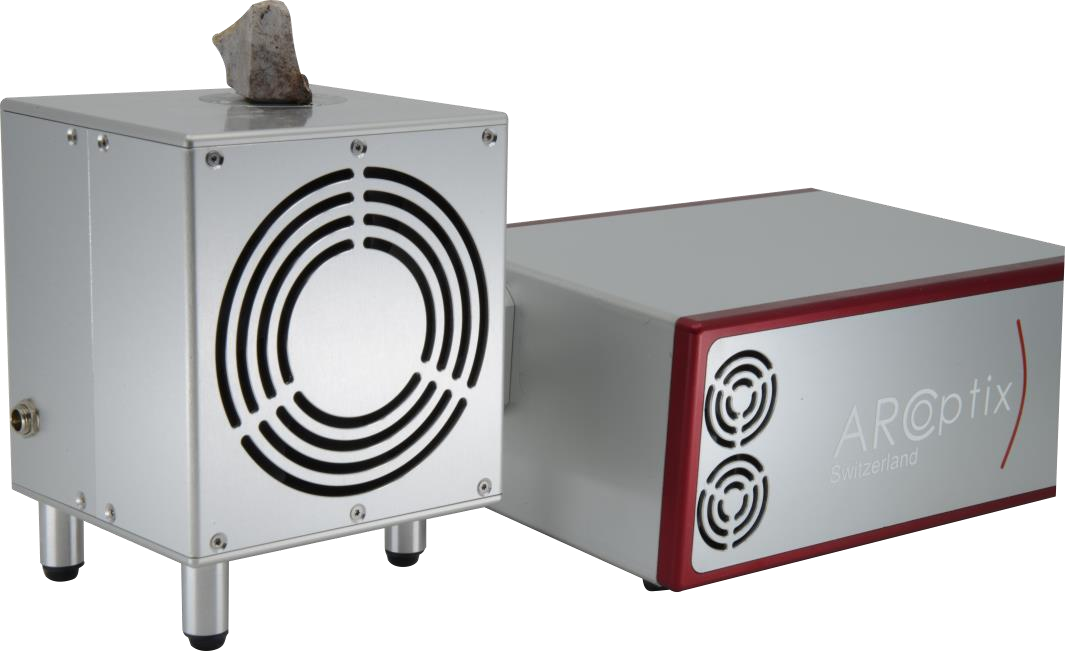Diffuse reflectance (DR) measurement is a primary field of analysis in infrared spectroscopy, that offers access to a large compound of information from various solid samples such as minerals, plants, plastics etc. ARCoptix offers several acquisition setups and accessories that allow addressing the various applications of DR spectroscopy. The ARCoptix ARCSPHERE-MIR is an ideal platform for DR spectroscopy delivering stable and repeatable results.

ARCSPHERE-MIR coupled to the FTMIR-L1-120-4TE
The following equipment was used to acquire the results showed in this document:
- ARCSPHERE-MIR:Integrating sphere with internal illumination
- FTMIR-L1-120-4TE:FT-IR spectrometer with 4TEC 2-\( 12\mu\text{m} \) MCT detector
- PART-DRS-MIR:Diffused gold reflectance standard
- Panorama:General use spectroscopy software from (Labcognition GmbH)
- USGS Spectral library:Freely available infrared spectroscopy library
After turning on the FTMIR-L1-120-4TE and the ARCSPHERE-MIR and let the system reach steady-state for ~1h, the PART-DRS-MIR was used to obtain a reference spectrum with a resolution of 8cm-1, Norton-Beer Weak apodization and 128 averages, corresponding to ~15 s measurements. A dark reference was obtained with identical experimental parameters by leaving the sampling window on the ARCSPHERE-MIR empty. This dark reference was then subtracted from any subsequent acquisition.
The samples were then measured (parameters remained unchanged) and compared to an existing database (USGS Spectral library - version 7) using the Panorama software. The results for two mineral samples (labelled M_6219 and Pigment_Malachite) are showcased here below.

Library closest match (green) compared to the reflectance spectrum measured using the ARCoptix setup (red). The results point out to Alunite for the unknown sample M_6219. The second sample was known to be Malachite and is compared to its reference spectrum
The setup was then used to measure powdered Paracetamol (acetaminophen), which is a commonly available sample. The results obtained using the ARCoptix ARCSPHERE-MIR and FTMIR-L1-120-4TE are shown in red, and can be compared to a reference obtained from the NIST (National Institue of Standards and Technology) in blue.

Reference spectrum for acetaminophenol from the NIST library (blue) compared to the diffuse reflectance spectrum of powdered paracetamol measured using the ARCSPHERE-MIR and FTMIR-L1-120-4TE.
The ARCSPHERE-MIR coupled to our FTMIR-L1-120-4TE showed to be a suitable platform for characterizing samples through diffuse reflectance measurements and obtaining good qualitative results. Overall, the results are in good agreement. Observable differences are attributed to the following factors:
- In the case of library matching (first two results), the samples are naturally different from their reference, both in terms of composition and also form. Our samples were actual rocks, whilst the spectra composing the USGS spectral library are powders.
- In some cases, a noticeable tilt of the baseline can be observed at wavenumbers < 1500 cm-1. This is due to the sample re-emitting part of the energy it absorbed from the illumination and which adds to the overall diffuse reflection. This effect, intrinsic to the measurement method, can be potentially alleviated by means of targeted baseline correction algorithms. These routines require to be adjusted to each sample, as the resulting re-emission will depend on its physical properties (absorption, emissivity, temperature, etc.)
